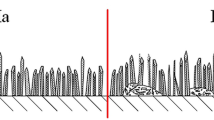Abstract
A conjugate gradient method (CGM) based on the inverse algorithm is used to estimate the unknown fouling-layer profile on the inner wall of a pipe system using simulated temperature measurements taken within the pipe wall. It is assumed that no prior information is available about the functional form of the unknown profile. Therefore, the procedure is classified as the function estimation in inverse calculation. The temperature data obtained from the direct problem are used to simulate the temperature measurements. The accuracy of the inverse analysis is examined using the simulated exact and inexact temperature measurements. The results show that the excellent estimation of the fouling-layer profile can be obtained for the test case considered in this study. The technique presented in this study can be used in a warning system to call for pipe maintenance when the thickness of fouling exceeds a predefined criterion.
Similar content being viewed by others
Abbreviations
- h :
-
convection heat transfer coefficient W·m−2·K−1
- J :
-
functional
- J′:
-
gradient of functional
- k :
-
thermal conductivity, W·m−1·K−1
- L :
-
length of the pipe, m
- M :
-
total number of measuring positions
- p :
-
direction of descent
- R 1 :
-
inner radius of the pipe, m
- R 2 :
-
outer radius of the pipe, m
- r :
-
spatial radial coordinate, m
- T :
-
temperature, K
- T in :
-
inlet temperature, K
- T ∞ :
-
ambient temperature, K
- u x :
-
axial fluid velocity, m·s−1
- x :
-
spatial axial coordinate, m
- Y :
-
measurement temperature, K
- Δ:
-
small variation quality
- α :
-
thermal diffusivity, m2·s−1
- β :
-
step size
- γ :
-
conjugate coefficient
- η :
-
very small value
- λ :
-
variable used in the adjoint problem
- σ :
-
standard deviation
- \( \varpi \) :
-
random variable
References
Jarny, Y., Ozisik, M. N., and Bardon, J. B. A general optimization method using an adjoint equation for solving multidimensional inverse heat conduction. International Journal of Heat and Mass Transfer, 34(11), 2911–2919 (1991)
Yang, Y. C., Chu, S. S., and Chang, W. J. Thermally-induced optical effects in optical fibers by inverse methodology. J. Appl. Phys., 95(9), 5159–5165 (2004)
Chen, W. L., Yang, Y. C., and Lee, H. L. Inverse problem in determining convection heat transfer coefficient of an annular fin. Energy Conversion and Management, 48(4), 1081–1088 (2007)
Chiang, C. C. and Chou, S. K. Inverse geometry design problem in optimizing hull surfaces. Journal of Ship Research, 42(2), 79–85 (1998)
Huang, C. H. and Chen, H. M. An inverse geometry problem of identifying growth of boundary shapes in a multiple region domain. Numerical Heat Transfer, Part A: Applications, 35(4), 435–450 (1999)
Park, H. M. and Shin, H. J. Empirical reduction of modes for the shape identification problems of heat conduction systems. Computer Methods in Applied Mechanics and Engineering, 192(15), 1893–1908 (2003)
Park, H. M. and Shin, H. J. Shape identification for natural convection problems using the adjoint variable method. J. Comput. Phys., 186(1), 198–211 (2003)
Divo, E., Kassab, A. J., and Rodriguez, F. An efficient singular superposition technique for cavity detection and shape optimization. Numerical Heat Transfer, Part B: Foundamentals, 46(1), 1–30 (2004)
Kwag, D. S., Park, I. S., and Kim, W. S. Inverse geometry problem of estimating the phase front motion of ice in a thermal storage system. Inverse Problems in Science and Engineering, 12(1), 1–15 (2004)
Su, C. R. and Chen, C. K. Geometry estimation of the furnace inner wall by an inverse approach. International Journal of Heat and Mass Transfer, 50(19–20), 3767–3773 (2007)
Yang, X. D. and Qiao, Z. D. Optimum aerodynamic design of transonic wing based on adjoint equations method (in Chinese). Acta Aeronautica et Astronautica Sinica, 24(1), 1–5 (2003)
Yang, X. D., Qiao, Z. D., and Zhu, B. Aerodynamic design method based on control theory and Navier-Stokes equations (in Chinese). Acta Aerodynamica Sinica, 23(1), 46–51 (2005)
Yang, Y. C. and Chang, W. J. Simultaneous inverse estimation for boundary heat and moisture fluxes of a double-layer annular cylinder with interface resistance. Appl. Math. Comput., 176(2), 594–608 (2006)
Chen, W. L., Yang, Y. C., and Lee, H. L. Estimating the absorptivity in laser processing by inverse methodology. Appl. Math. Comput., 190(1), 712–721 (2007)
Lee, H. L., Yang, Y. C., Chang, W. J., and Wu, T. S. Estimation of heat flux and thermal stresses in multilayer gun barrel with thermal contact resistance. Appl. Math. Comput., 209(2), 211–221 (2009)
Alifanov, O. M. and Artyukhin, E. A. Regularized numerical solution of nonlinear inverse heat-conduction problem. Journal of Engineering Physics, 29(1), 934–938 (1975)
Zueco, J. and Alhama, F. Simultaneous inverse determination of temperature-dependent thermo-physical properties in fluids using the network simulation method. International Journal of Heat and Mass Transfer, 50(15–16), 3234–3243 (2007)
Alifanov, O. M. Inverse Heat Transfer Problems, Springer-Verlag, New York (1994)
Alifanov, O. M. Application of the regularization principle to the formulation of approximate solution of inverse heat conduction problem. Journal of Engineering Physics, 23(6), 1566–1571 (1972)
Lien, F. S., Chen, W. L., and Leschziner, M. A. A multiblock implementation of a non-orthogonal, collocated finite volume algorithm for complex turbulent flows. Interational Journal for Numerical Methods in Fluids, 23(6), 567–588 (1996)
Author information
Authors and Affiliations
Corresponding author
Additional information
Project supported by the National Science Council of Taiwan of China (No. NSC 97-2221-E-168-039)
Rights and permissions
About this article
Cite this article
Chen, Wl., Yang, Yc., Lee, Hl. et al. Inverse estimation for unknown fouling geometry on inner wall of forced-convection pipe. Appl. Math. Mech.-Engl. Ed. 32, 55–68 (2011). https://doi.org/10.1007/s10483-011-1393-9
Received:
Revised:
Published:
Issue Date:
DOI: https://doi.org/10.1007/s10483-011-1393-9




